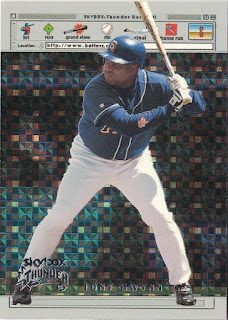A couple of days ago I read a post on Fuji's blog about these cards. Mine has been sitting in my 'to blog' pile for a while and Fuji's post made me realise that I could blog a card that is weirdly totally relevant to what is going on in baseball now.
As most fans know, currently there is an impasse between the franchise owners and the players. Spring Training has been cancelled and soon they will start cancelling games unless a compromise is found. There is a possibility of no baseball at all in 2022.
In 1994, a similar breakdown in relations meant the season was cut short. Tony was batting .394 at that point and it remains the highest batting average since the Second World War. But it was a shortened season and the unanswered question is - what would Tony have batted if the season had run to a full conclusion?
Tony was just 7 hits off .400 at the point where the season was cancelled. Could he have recovered that deficit in his remaining games?
In 1995 Topps produced a parallel that used a "computer" to predict what a player's totals would have been if the full season had been completed in the previous season. Topps called these parallels "cyber stats". The regular base card is blogged here.
Card Number 974: Topps Cyber Stats parallel, 1995; #228
These cards have different numbers to the base cards. Tony's base card in 1995 was #431. The front is shiny and this is an admittedly poor scan.
On the back is the "computer generated" stats, which predicted a drop off in the final 6 weeks of the season from .394 to .391. I dispute this but accept that the processing power available back in 1994-1995 was pretty low and this may have made sense within the parameters they were working with.
However, there are some additional aspects of Tony's batting in 1994 that need to be taken into account. These were brought to my attention initially by some
Upper Deck SP cards.
Firstly, if you take the last few games of the 1993 season, and add them to the games of the 1994 season to make a complete 162 games played, Tony batted .396 across those games. Now, this is a bit moot because Tony never actually batted a complete 162-game season. But he was hot at the end of the 1993 season and there is no reason to believe he wouldn't have been hot at the end of the 1994 season, had it happened.
Secondly, if you look at Tony's performance across the 1994 season, he was getting stronger as the season went on. In the 30 games before the season was halted, Tony was hitting .433, dragging his average up considerably. If he had carried on batting at that rate for the remainder of the season he would have gone past .400 quite easily.
I very much doubt the computer algorithm that Topps used to calculate Tony's potential scores took either of those factors into account.
And another thing occurred to me about this card, and it supports my thesis that the social changes of the Nineties were seismic compared to previous decades. This was the beginning of the desktop computer era, where suddenly everything transitioned to computer-based working and the foundations were laid for the Internet and life online.
This is reflected in baseball cards in a number of ways. Obviously one of the most noticeable changes is the impact on the design of baseball cards. But in this case, the impact of computers is on the content of the card.
It's testament to a time where computers were rapidly becoming a normal part of life, so of course it would be a "computer generated" prediction of what would have happened - it almost had to be a "cyber stat" because cyber was the imminent future.
Total: 974 cards




















































